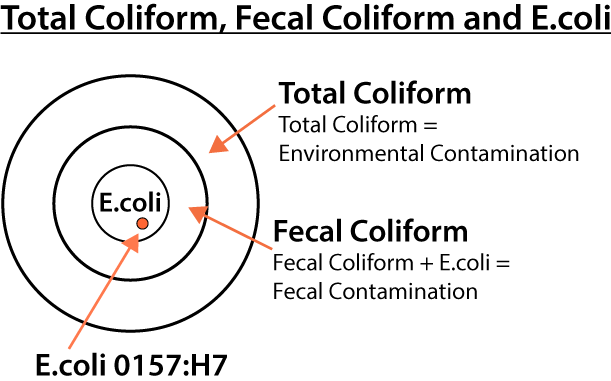
- Pathogens that enter into bodies of water arrive there via intestinal discharges of humans or other animals.
- Furthermore, certain bacterial species, particularly Esherichia coli and related organisms designated as coliforms, fecal streptococci (e.g. Streptococcus faecalis), and Clostridium perfringens, are normal inhabitants of the large intestine of humans and other animals and are consistently present in feces.
- Thus, fecal pollution of human or animal origin in water is indicated by the presence of any of these bacterial species.
The Coliform group of bacteria:
- All aerobic and facultatively anaerobic, Gram-negative, non sporulating bacilli that produce acid and gas from the fermentation of lactose belong to coliform group of bacteria.
- The classical species of this group are Escherichia coli and Enterobacter aerogens. Escherichia coli is a normal inhabitant of the intestinal tract of humans and other animals.
- Enterobacter aerogens is most frequently found on grains and plants but may occur in human and animal feces. They show similar morphological and cultural characteristics.
- Consequently, it is necessary to resort to biochemical tests for differentiation.
Following biochemical tests are important for this purpose:
- Ability to produce indole from tryptophan. E. coli does, and Enterobacter aerogens does not.
- Amount of acidity produced in a special glucose-broth medium and detected by the pH indicator methyl red. Both organisms produce acid from glucose. However, E. coli produces a lower pH, which turns the indicator red, whereas Enterobacter aerogens cultures don’t produce as large an amount of acid and thus don’t produce the color change.
- Ability to produce the compound acetylmethylcarbinol in a glucose-peptone medium. Voges- Proskauer test procedure detects the formation of this chemical. E. coli doesn’t produce acetylmethylcarbinol, but Enterobacter aerogens does.
- Utilization of sodium citrate. Enterobacter aerogens is capable of utilizing sodium citrate as its sole source of carbon; E. coli doesn’t grow under the same circumstances.
- The reactions for all coli-aerogenes organisms are unfortunately not as clear-cut as those mentioned above.
- Some cultures give other combinations of reactions to this scheme of testing and are usually referred to as intermediate types.
- Furthermore, there are additional coliform species in the genera Klebsiella and Citrobacter for which more detailed biochemical, genetic, and immunologic data are needed for identification.